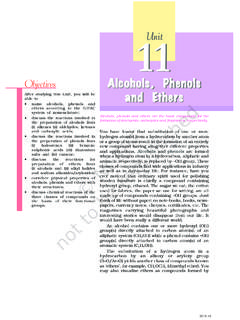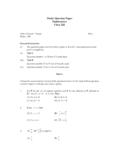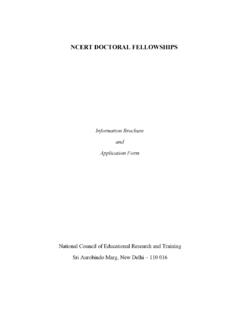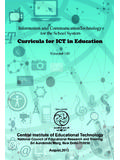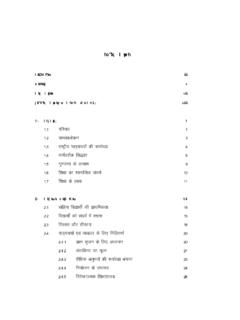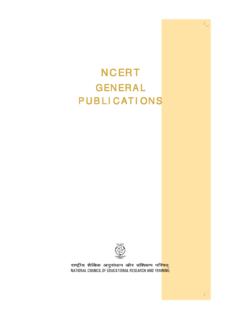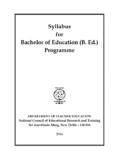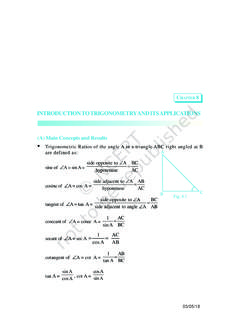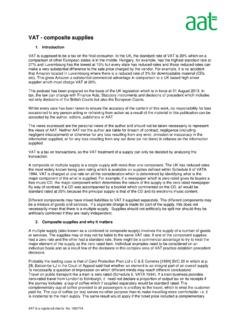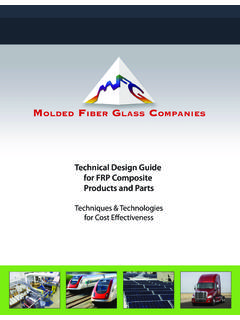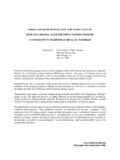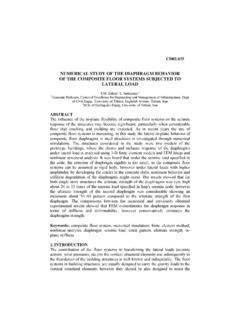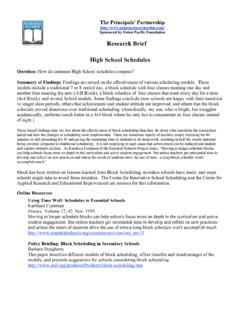Transcription of MATHEMATICS (CLASSES XI –XII) - National Council Of ...
1 1 MATHEMATICS ( classes XI XII)General Guidelines(i) All concepts/identities must be illustrated by situational examples.(ii)The language of word problems must be clear, simple and unambiguous.(iii)Problems given should be testing the understanding of the subject.(iv)All proofs to be produced in a manner that allow the learner to see flow of reasons. Whereverpossible, give more than one proof.(v) Motivate results, wherever possible. Prove explicitly those results where a short and clear argumentreinforces mathematical thinking and reasoning. There must be emphasis on correct way ofexpressing the XI(Total Periods 180)UNIT I: SETS AND FUNCTIONS1. Sets(Periods 12)Sets and their representations. Empty set. Finite and Infinite sets. Equal sets. Subsets. Subsets of theset of real numbers especially intervals (with notations). Power set. Universal set. Venn diagrams. Unionand intersection of sets. Difference of sets. Complement of a set, Properties of Complement Relations and Functions(Periods 14)Ordered pairs, Cartesian product of sets.
2 Number of elements in the Cartesian product of twofinite sets. Cartesian product of the reals with itself (upto R R R).Definition of relation, pictorial diagrams, domain, co-domain and range of a relation. Function asa special kind of relation from one set to another. Pictorial representation of a function, domain,co-domain and range of a function. Real valued function of the real variable, domain and range ofthese functions, constant, identity, polynomial, rational, modulus, signum and greatest integerfunctions with their graphs. Sum, difference, product and quotients of Trigonometric Functions(Periods 18)Positive and negative angles. Measuring angles in radians and in degrees and conversion fromone measure to another. Definition of trigonometric functions with the help of unit circle. Truth ofthe identity sin2x + cos2x = 1, for all x. Signs of trigonometric functions and sketch of theirgraphs. Expressing sin (x+ y) and cos (x + y) in terms of sin x, sin y,cos x and cos y.
3 Deducing the identities like following:tan (x + y) tantancot cot1,cot()1 tantancotcotxyxyxyxyyx = = sin x + sin y = 2 , coscos2 coscos2222xyxyxyxyxy+ + +=sin x sin y = 2 , coscos2 sinsin2222xyxyxyxyxy+ + = Identities related to sin2x, cos2x, tan2x, sin3x, cos3x and tan3x. General solution of trigonometricequations of the type sin = sin , cos = cos and tan = tan . Proofs and simple applicationsof sine and cosine II : ALGEBRA1. Principle of Mathematical Induction(Periods 06)Process of the proof by induction, motivating the application of the method by looking at naturalnumbers as the least inductive subset of real numbers. The principle of mathematical inductionand simple Complex Numbers and Quadratic Equations(Periods 10)Need for complex numbers, especially 1 , to be motivated by inability to solve every quadraticequation. Brief description of algebraic properties of complex numbers. Argand plane and polarrepresentation of complex numbers.
4 Statement of Fundamental Theorem of Algebra, solution ofquadratic equations in the complex number system, Square-root of a Complex Linear Inequalities(Periods 10)Linear inequalities, Algebraic solutions of linear inequalities in one variable and their representationon the number line. Graphical solution of linear inequalities in two variables. Solution of system oflinear inequalities in two variables - Permutations and Combinations(Periods 12)Fundamental principle of counting. Factorial n. Permutations and combinations derivation offormulae and their connections, simple Binomial Theorem(Periods 08)History, statement and proof of the binomial theorem for positive integral indices. Pascal s triangle,general and middle term in binomial expansion, simple Sequence and Series(Periods 10)Sequence and Series. Arithmetic Progression ( ), Arithmetic Mean ( ), GeometricProgression ( ), general term of a , sum of n terms of a Arithmetic and geometricseries, infinite and its sum, geometric mean ( ).
5 Relation between and Sumto n terms of the special series : 23,andnnn UNIT III : COORDINATE GEOMETRY1. Straight Lines(Periods 09)Brief recall of 2-D from earlier classes , shifting of origin. Slope of a line and angle between twolines. Various forms of equations of a line: parallel to axes, point-slope form, slope-interceptform, two-point form, intercepts form and normal form. General equation of a line. Equation offamily of lines passing through the point of intersection of two lines. Distance of a point from Conic Sections(Periods 12)Sections of a cone: Circles, ellipse, parabola, hyperbola, a point, a straight line and pair ofintersecting lines as a degenerated case of a conic section. Standard equations and simple propertiesof parabola, ellipse and hyperbola. Standard equation of a Introduction to Three-dimensional Geometry(Periods 08)Coordinate axes and coordinate planes in three dimensions. Coordinates of a point. Distancebetween two points and section IV : CALCULUSL imits and Derivatives(Periods 18)Derivative introduced as rate of change both as that of distance function and geometrically,intuitive idea of limit.
6 +00log (1 ) 1lim,limxexxxexx. Definition of derivative, relate it to slopeof tangent of the curve, derivative of sum, difference, product and quotient of functions. Derivativesof polynomial and trigonometric V: MATHEMATICAL REASONING(Periods 08)Mathematically acceptable statements. Connecting words/phrases - consolidating theunderstanding of if and only if (necessary and sufficient) condition , implies , and/or , impliedby , and , or , there exists and their use through variety of examples related to real life andMathematics. Validating the statements involving the connecting words - difference betweencontradiction, converse and VI : STATISTICS AND PROBABILITY1. Statistics(Periods 10)Measure of dispersion; mean deviation, variance and standard deviation of ungrouped/groupeddata. Analysis of frequency distributions with equal means but different Probability(Periods 15)Random experiments: outcomes, sample spaces (set representation). Events: Occurrence ofevents, not , and & or events, exhaustive events, mutually exclusive events.
7 Axiomatic (settheoretic) probability, connections with the theories of earlier classes . Probability of an event,probability of not , and , & or XII(Total Periods 180)UNIT I: RELATIONS AND FUNCTIONS1. Relations and Functions(Periods 10)Types of relations: Reflexive, symmetric, transitive and equivalence relations. One to one and ontofunctions, composite functions, inverse of a function. Binary Inverse Trigonometric Functions(Periods 12)Definition, range, domain, principal value branches. Graphs of inverse trigonometric properties of inverse trigonometric II: ALGEBRA1. Matrices(Periods 18)Concept, notation, order, equality, types of matrices, zero matrix, transpose of a matrix, symmetricand skew symmetric matrices. Addition, multiplication and scalar multiplication of matrices, simpleproperties of addition, multiplication and scalar multiplication. Non-commutativity of multiplicationof matrices and existence of non-zero matrices whose product is the zero matrix (restrict to squarematrices of order 2).
8 Concept of elementary row and column operations. Invertible matrices andproof of the uniqueness of inverse, if it exists; (Here all matrices will have real entries).2. Determinants(Periods 20)Determinant of a square matrix (up to 3 3 matrices), properties of determinants, minors, cofactorsand applications of determinants in finding the area of a triangle. Adjoint and inverse of a squarematrix. Consistency, inconsistency and number of solutions of system of linear equations by examples,solving system of linear equations in two or three variables (having unique solution) using inverse ofa III: CALCULUS1. Continuity and Differentiability(Periods 18)Continuity and differentiability, derivative of composite functions, chain rule, derivatives of inversetrigonometric functions, derivative of implicit function. Concepts of exponential, logarithmic of logex and ex. Logarithmic differentiation. Derivative of functions expressed in parametricforms. Second order derivatives.
9 Rolle s and Lagrange s Mean Value Theorems (without proof)and their geometric Applications of Derivatives(Periods 10)Applications of derivatives: Rate of change, increasing/decreasing functions, tangents and normals,approximation, maxima and minima (first derivative test motivated geometrically and second derivativetest given as a provable tool). Simple problems (that illustrate basic principles and understanding ofthe subject as well as real-life situations).63. Integrals(Periods 20)Integration as inverse process of differentiation. Integration of a variety of functions by substitution,by partial fractions and by parts, only simple integrals of the type ++ ++ 22222 222,,, , ,dxdxdxdxdxxaaxbxcxaaxaxbxc()()++ ++++ 222222,,and,pxqpxqdxdxaxdxxadxaxbxcaxbxc ()+++++ 22andaxbxcdxpxqaxbxcdxto be integrals as a limit of a sum. Fundamental Theorem of Calculus (without proof). Basicproperties of definite integrals and evaluation of definite Applications of the Integrals(Periods 10)Applications in finding the area under simple curves, especially lines, arcs of circles/parabolas/el-lipses (in standard form only), area between the two above said curves (the region should be cleralyidentifiable).
10 5. Differential Equations(Periods 10)Definition, order and degree, general and particular solutions of a differential equation. Formation ofdifferential equation whose general solution is given. Solution of differential equations by method ofseparation of variables, homogeneous differential equations of first order and first degree. Solutionsof linear differential equation of the type ,dyPyQdx+= where P and Q are functions of x or constant+=,dxPxQdy where P and Q are functions of y or constantUNIT IV: VECTORS AND THREE-DIMENSIONAL GEOMETRY1. Vectors(Periods 10)Vectors and scalars, magnitude and direction of a vector. Direction cosines/ratios of vectors. Typesof vectors (equal, unit, zero, parallel and collinear vectors), position vector of a point, negative of avector, components of a vector, addition of vectors, multiplication of a vector by a scalar, positionvector of a point dividing a line segment in a given ratio. Scalar (dot) product of vectors, projectionof a vector on a line.
